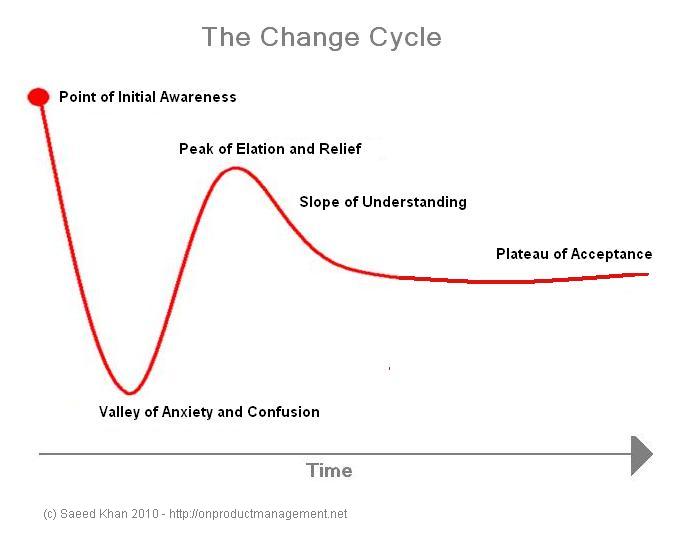I’ve written previously about change being a process. At the recent ProductCamp Toronto, I spoke about this a bit more and introduced what I call The Change Cycle.
(click to enlarge)
This gives more detail into the process many people go through when they become aware of significant changes in their environment. This could be related to their job, company, community, family or other group or context they belong to.
For those of you familiar with a certain analyst firm’s Hype Cycle, you may see a bit of a resemblance, but this applies to how people react to change, and not how markets adopt new technologies.
A lot of this could probably be proven by psychologists (any out there?), but I’m not one so I’ll forego that.
This curve is based on empirical evidence and my own observations of how people tend to react to any significant news of change that could potentially affect them.
The Change Cycle consists of 5 phases:
- Point of initial awareness – This is the start of the Change Cycle and occurs when a person or group of people first hear about a significant change in their environment
- Valley of Anxiety and Confusion – Upon hearing the impactful news, the first thing most people do is worry about how it will affect them individually. They start thinking about worst-case scenarios or the potential fallout of the change on their roles, jobs, careers and lives. In short, they worry because they have incomplete information, they don’t know what the future will hold and their psyche fills in the gaps, usually with negative information.
- Peak of Elation and Relief – In most cases the impact is not as bad as originally thought and fears and anxiety subside. People may even chide themselves for being worry worts and feel relieved that they will not be impacted as harshly as originally thought.
- Slope of Understanding – As the change process starts happening, more information is provided. And with more context and clarity about the future, people start to see their new roles and situation in light of the change.
- Plateau of Acceptance – The final stage occurs as people embrace the change. This doesn’t happen at the same pace for everyone, and in some cases, there will be individuals who will not fully accept change. But over time, the new situation becomes the norm, and the process will start over again when the next Point of Initial Awareness is encountered.
For Product Managers — who are agents of change — keep reminding yourself that at the very core, change impacts people and their willingness to accept it is critical for positive changes to happen.
Help people reach the Slope of Understanding, but from their context, not yours, and you’ll see positive changes flow through your company or teams much more effectively.
Thoughts? Comments? I’d love to hear them.
Saeed
